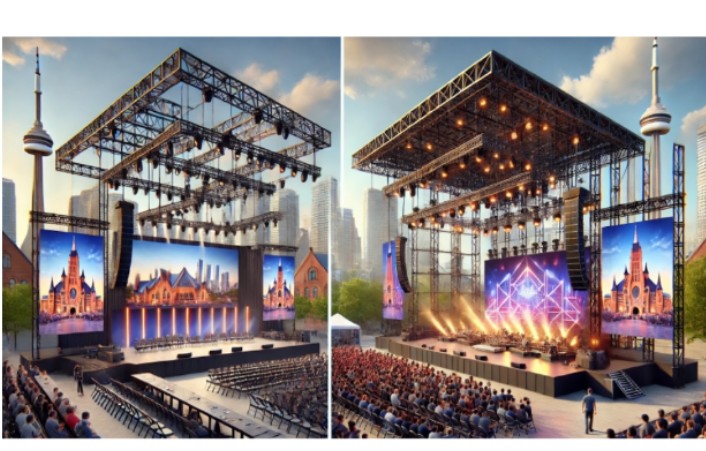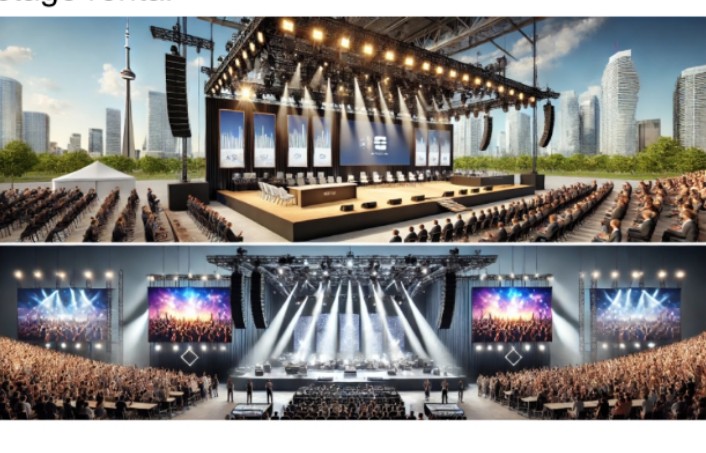When planning an event, whether it’s a corporate conference, concert, wedding, or community festival, the stage is the heart of the experience. Stage Rentals It’s where speakers deliver powerful messages, performers entertain, and memorable moments unfold. In a city like Toronto, where events range from intimate gatherings to large-scale productions, customizable stage rentals are essential to accommodate the diverse needs of organizers. Whether you’re an event organizer or an individual planning your own event, understanding the options and benefits of customizable stage rentals can make all the difference in the success of your event.

Image Credit Goes to Toronto Audio Visual Rentals
In this guide, we’ll walk you through everything you need to know about customizable stage rentals in Toronto, from the types of stages available to the essential features and services that can elevate your event. We aim to provide insights that aren’t readily available on the internet and help you make informed decisions tailored to your unique event requirements.
1. The Importance of Customizable Stage Rentals
Customizable stages are becoming increasingly popular because no two events are alike. Whether you’re hosting a business conference or a wedding reception, the stage needs to reflect the theme, ambiance, and practical needs of the event. Here are some reasons why customizable stage rentals are crucial for your event:
- Personalization: From stage size to design, you can tailor every aspect to suit your event.
- Versatility: These stages are versatile and can be adapted to various event types, from concerts to corporate meetings.
- Enhanced Audience Engagement: A well-designed stage draws attention, keeping the audience focused and engaged.
- Safety and Compliance: Custom stages ensure that they meet the safety regulations required for the specific nature of your event, which can include weight-bearing capacities or special setups for unique locations.
2. Types of Customizable Stage Rentals
Toronto offers a wide variety of stage rental options that can cater to any event. Here are the most common types of stages you can rent and customize based on your event needs:
a. Portable Stages
Portable stages are the most common rental option for events that require mobility or frequent reconfiguration. These stages are modular, allowing event organizers to adjust the size and height of the stage as needed. They are also easy to set up and dismantle, making them ideal for events that require quick transitions.
Benefits:
- Easily customizable in terms of height and dimensions.
- Quick to assemble and disassemble.
- Suitable for both indoor and outdoor events.
b. Truss Stages
Truss stages are perfect for larger events that require heavy-duty support, such as concerts or festivals. They come with a built-in structure that can hold lighting rigs, sound equipment, and other stage effects. This type of stage is ideal if your event requires sophisticated audio-visual elements.
Benefits:
- Excellent for heavy-duty lighting and sound setups.
- Strong and sturdy, suitable for large-scale events.
- Customizable to different shapes and sizes.
c. Runway Stages
Runway stages are ideal for fashion shows, talent performances, or events that require a unique stage setup. These stages typically have a narrow, extended design to allow presenters or performers to walk down the stage and interact more closely with the audience.
Benefits:
- Unique design that promotes audience interaction.
- Perfect for fashion events or performances.
- Can be customized for length and width.
d. Round Stages
Round stages offer a 360-degree view, making them perfect for concerts, speeches, and performances where audience engagement is critical. These stages are less common but highly impactful, especially for performances where audience interaction is key.
Benefits:
- Unique, attention-grabbing design.
- Suitable for events with audience interaction from all sides.
- Customizable in terms of size and height.
3. Customizable Features to Consider
Customizing your stage rental involves more than just picking the type of stage. Here are key features and elements you can customize to create the perfect setting for your event:
a. Size and Height
One of the most critical factors in choosing a stage is determining the size and height that best fits your event. Small events may only need a compact stage, while large events such as concerts or conventions will require a larger platform. Many rental companies offer modular stages that can be adjusted based on the size of your venue and audience.
b. Stage Skirting and Decking
Stage skirting and decking can enhance the visual appeal of your stage, especially for formal or high-profile events. Skirting adds a polished look by covering the legs of the stage, while decking allows you to choose from a variety of materials like carpet, wood, or vinyl to match the theme of your event.
c. Lighting and Sound Integration
Customizable stages often come with options for integrating lighting and sound equipment. Whether it’s simple spotlights for a speaking event or a full rig of concert lighting, ensuring that your stage can support the necessary equipment is essential. For larger events, renting audio-visual services along with your stage can save time and ensure compatibility.
d. Accessibility Options
Inclusion is vital when planning an event, so consider adding ramps or lifts to ensure that your stage is accessible to all guests, including those with mobility challenges. Many rental companies in Toronto offer ADA-compliant stage setups, allowing you to create an event space that is welcoming and inclusive.
4. How to Choose the Right Stage Rental for Your Event
Selecting the right stage rental depends on several factors, and making the right decision can significantly impact the success of your event. Here are some steps to guide you through the decision-making process:
a. Assess Your Event Type and Audience Size
Start by considering the type of event you’re hosting and the size of your audience. For smaller, intimate gatherings, a portable stage may suffice, while larger events will require more substantial setups like truss or round stages.
b. Consider Venue Size and Location
The size and layout of your venue will play a major role in your stage selection. If you’re hosting an outdoor event, you’ll need a stage that can withstand the elements, whereas indoor venues may have size or height restrictions.
c. Audio-Visual Requirements
Think about the technical requirements for your event, including lighting, sound, and special effects. If you’re planning a concert or large-scale presentation, you’ll need a stage that can support these elements, along with the necessary equipment to enhance the performance.
d. Budget Considerations
Your budget will naturally influence your decision, but remember that stage rentals are often customizable to fit various price points. It’s essential to weigh the importance of certain features like stage size, lighting, and accessibility against your available funds.
Pro Tip: You can also seek assistance from reputable guides and tips regarding AV rentals.
5. Beyond the Stage: Audio Visual Rentals for a Seamless Event
In addition to stage rentals, most event organizers also need reliable audio-visual equipment to ensure a seamless experience for attendees. Partnering with a company that offers both stage and audio-visual rentals can streamline the process and ensure that all technical aspects of your event are handled professionally. Some key audio-visual components to consider include:
- Sound Systems: From microphones to speakers, the quality of your sound system can make or break the audience’s experience.
- Lighting: Stage lighting helps set the mood and ensure that performers or speakers are visible to the entire audience.
- Projection and Screens: If your event includes visual presentations, having high-quality projection equipment and screens is crucial for clear visibility.
6. The Future of Customizable Stage Rentals: Trends to Watch
The event rental industry is constantly evolving, with new trends and innovations making customizable stages even more dynamic. Here are some trends to keep an eye on for the future:
- Sustainable Staging: Many companies are shifting towards eco-friendly materials and energy-efficient lighting options to reduce their carbon footprint.
- Interactive Stages: With advances in technology, interactive stages that incorporate digital displays, holograms, and augmented reality are becoming more popular, especially for tech conferences and corporate events.
- Hybrid Events: As hybrid events (a mix of in-person and virtual) continue to rise, stages that are optimized for both live and digital audiences will become a standard requirement for many events.
Conclusion
Customizable stage rentals in Toronto provide the flexibility and versatility required to make any event a success. Whether you’re organizing a large-scale concert or an intimate wedding, having the right stage setup can enhance the overall experience for both performers and attendees. By considering factors like stage type, size, audio-visual needs, and budget, you can find a stage rental solution that perfectly fits your event’s unique requirements.
When choosing a stage rental provider, be sure to select a company that offers comprehensive services, including audio-visual support, lighting, and customizable options. With the right setup, your event will not only look professional but also provide a memorable experience for all who attend.






